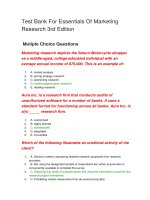Test bank for textbook of diagnostic sonography 7th edition by hagen ansert
Bạn đang xem bản rút gọn của tài liệu. Xem và tải ngay bản đầy đủ của tài liệu tại đây (46.26 KB, 5 trang )
buy this full document at
Hagen: Textbook of Diagnostic Sonography, 7th Edition
Chapter 01: Foundations of Sonography
Test Bank
MULTIPLE CHOICE
1.
a.
b.
c.
d.
Historically, the development of ultrasound began shortly after:
Radio communication in World War I
Sonar in World War II
Nuclear testing in World War II
The launching of Sputnik
ANS: B
World War II brought sonar equipment to the forefront for defense purposes. Ultrasound was
influenced by the success of sonar equipment.
PTS: 1
REF: p. 5
OBJ: Detail a timeline for pioneers in the advancement of medical diagnostic ultrasound.
TOP: History of ultrasound
2.
a.
b.
c.
d.
The early applications of obstetric ultrasound were initiated by:
Joseph Holmes
Ian Donald
John Howry
William Fry
ANS: B
The early obstetric compound scanner was built by Tom Brown and Dr. Ian Donald in
Scotland in 1957.
PTS: 1
REF: p. 6
OBJ: Detail a timeline for pioneers in the advancement of medical diagnostic ultrasound.
TOP: History of ultrasound
3.
a.
b.
c.
d.
Visualization of the cardiac structures in the heart was discovered by:
Joseph Holmes
Ian Donald
Hertz and Edler
George Ludwig
ANS: C
In 1954, echocardiographic techniques were developed in Sweden by Drs. C.H. Hertz and I.
Edler.
buy this full document at
Full file at />PTS: 1
REF: p. 6
OBJ: Detail a timeline for pioneers in the advancement of medical diagnostic ultrasound.
TOP: History of ultrasound
4. Which one of the following statements about the role of sonographers is false?
a. Sonographers perform ultrasound studies and gather diagnostic data independent
of the physician.
b. Sonographers must possess intellectual curiosity and perseverance.
c. Sonographers must have a technical aptitude.
d. Sonographers must be able to communicate on different levels.
ANS: A
A sonographer performs ultrasound studies gathering diagnostic data under both the direct
and the indirect supervision of a physician. They also must assess clinical history and
symptoms, interpret laboratory values, and understand other diagnostic examinations.
PTS: 1
REF: p. 3
OBJ: Describe a career in ultrasound.
TOP: Role of the sonographer
5.
a.
b.
c.
d.
In soft tissues, the assumed propagation velocity is (in meters per second):
1320
1450
1540
1650
ANS: C
In soft tissues, the assumed propagation velocity (speed) is 1540 meters per second.
PTS: 1
REF: p. 8
OBJ: Demonstrate an understanding of the basic principles and terminology of ultrasound.
TOP: Sonography principles and instrumentation
6.
a.
b.
c.
d.
Diagnostic ultrasound uses the frequencies of:
10 to 15 kHz
1 to 20 kHz
100 to 1000 Hz
1 to 20 MHz
ANS: D
Diagnostic application of ultrasound uses frequencies 1 to 20 million cycles per second (1 to
20 MHz).
PTS: 1
REF: p. 7
OBJ: Demonstrate an understanding of the basic principles and terminology of ultrasound.
TOP: Sonography principles and instrumentation
Copyright © 2012, 2006, 2001, 1995, 1989, 1983, 1978 by Mosby, an imprint of Elsevier Inc.
Full file at />7. Which one of the following correctly defines dynamic range?
a. Field farthest from the transducer during formation of the sound beam
b. Ratio of the largest to the smallest signals that an instrument can respond to
without distortion
c. Minimum distance between two structures positioned along the axis of the sound
beam
d. Measure of the strength of the ultrasound signal
ANS: B
Dynamic range is the ratio of the largest to the smallest signals that an instrument or
component of an instrument can respond to without distortion.
PTS: 1
REF: p. 17
OBJ: Demonstrate an understanding of the basic principles and terminology of ultrasound.
TOP: Sonography principles and instrumentation
8.
a.
b.
c.
d.
The device that converts energy from one form to another is called the:
Digitizer
Transducer
Scan converter
Beam former
ANS: B
Piezoelectric elements (transducers) convert electric energy into ultrasound energy and vice
versa.
PTS: 1
REF: p. 11
OBJ: Demonstrate an understanding of the basic principles and terminology of ultrasound.
TOP: Sonography principles and instrumentation
9. The _____ is the product of the velocity of sound in a medium and the density of that
medium.
a. Acoustic impedance
b. Sound reflection
c. Angle of reflection
d. Piezoelectric effect
ANS: A
The acoustic impedance is equal to the density multiplied by the sound propagation speed.
PTS: 1
REF: p. 9
OBJ: Demonstrate an understanding of the basic principles and terminology of ultrasound.
TOP: Sonography principles and instrumentation
10. The angle of reflection is equal to the:
Copyright © 2012, 2006, 2001, 1995, 1989, 1983, 1978 by Mosby, an imprint of Elsevier Inc.
Full file at />a.
b.
c.
d.
Acoustic impedance
Angle of incidence
Refraction
Image resolution
ANS: B
Angle of reflection is the angle between the reflected sound direction and a line
perpendicular to the media boundary.
PTS: 1
REF: p. 5
OBJ: Demonstrate an understanding of the basic principles and terminology of ultrasound.
TOP: Sonography principles and instrumentation
11. The best transducer to image the thyroid gland is:
a. Curved array, 3 MHz
b. Linear array, 5 MHz
c. Sector array, 4 MHz
d. Linear array, 3 MHz
ANS: B
High-frequency linear array transducers are generally used for smaller structures.
PTS: 1
REF: p. 12
OBJ: Identify ultrasound instruments and discuss their uses.
TOP: Sonography principles and instrumentation
12. The display mode that shows time along the horizontal axis and depth along the vertical
axis is:
a. A mode
b. B mode
c. M mode
d. Real time
ANS: C
Motion mode (M mode) displays the depth along the vertical axis versus the time along the
horizontal axis.
PTS: 1
REF: p. 14
OBJ: Identify ultrasound instruments and discuss their uses.
TOP: Sonography principles and instrumentation
13. Which one of the following statements about the Doppler principle is false?
a. Doppler refers to a change in frequency in which the motion of laminar flow is
detected within a vascular structure.
b. The beam should be perpendicular to the flow.
c. The Doppler shift is directly proportional to the velocity of the red cell.
Copyright © 2012, 2006, 2001, 1995, 1989, 1983, 1978 by Mosby, an imprint of Elsevier Inc.
Full file at />d. If the cell moves away from the transducer, then the fall in frequency is directly
proportional to the velocity and direction of the red blood cell movement.
ANS: B
The beam should be parallel to the flow to obtain the maximum velocity. The frequency of
the Doppler shift is proportional to the cosine of the Doppler angle. At a 90-degree angle
(perpendicular to flow), the Doppler shift is zero, regardless of the flow velocity.
PTS: 1
REF: p. 17
OBJ: Discuss three-dimensional and Doppler ultrasound.
TOP: Sonography principles and instrumentation
14. The Fresnel zone is also called the:
a. Far field
b. Focal point
c. Near zone
d. Nyquist limit
ANS: C
The Fresnel or near zone is the field closest to the transducer during the formation of the
sound beam.
PTS: 1
REF: p. 16
OBJ: Demonstrate an understanding of the basic principles and terminology of ultrasound.
TOP: Sonography principles and instrumentation
15. The higher the transducer frequency, the:
a. Shorter the wavelength
b. Faster the frame rate
c. Deeper the penetration depth
d. Slower the frame rate
ANS: A
The higher the frequency, the shorter the wavelength.
PTS: 1
REF: p. 9
OBJ: Demonstrate an understanding of the basic principles and terminology of ultrasound.
TOP: Sonography principles and instrumentation
Copyright © 2012, 2006, 2001, 1995, 1989, 1983, 1978 by Mosby, an imprint of Elsevier Inc.









